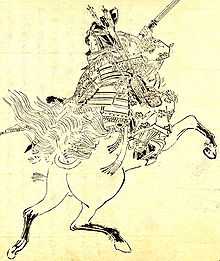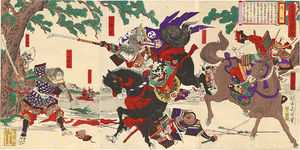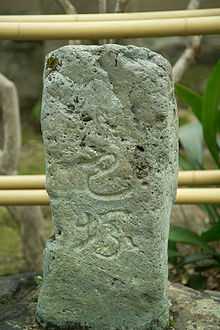Tomoe Gozen

Tomoe Gozen (巴 御前) (1157?–1247), pronounced [tomo.e], was a late twelfth-century female samurai warrior (onna bugeisha), known for her bravery and strength.[1] She is believed to have fought in and survived the Genpei War (1180–1185).
She was also the concubine of Minamoto no Yoshinaka.[2]
History
According to one historical account,
| “ | Tomoe was especially beautiful, with white skin, long hair, and charming features. She was also a remarkably strong archer, and as a swordswoman she was a warrior worth a thousand, ready to confront a demon or a god, mounted or on foot. She handled unbroken horses with superb skill; she rode unscathed down perilous descents. Whenever a battle was imminent, Yoshinaka sent her out as his first captain, equipped with strong armor, an oversized sword, and a mighty bow; and she performed more deeds of valor than any of his other warriors. |
” |
After defeating the Taira and driving them into the western provinces, Minamoto no Yoshinaka (Tomoe's master) took Kyoto and desired to be the leader of the Minamoto clan. His cousin Yoritomo was prompted to crush Yoshinaka, and sent his brothers Yoshitsune and Noriyori to kill him. Yoshinaka fought Yoritomo's forces at the Battle of Awazu on February 21, 1184, where Tomoe Gozen purportedly took at least one head of the enemy. Although Yoshinaka's troops fought bravely, they were outnumbered and overwhelmed. When Yoshinaka was defeated there, with only a few of his soldiers standing, he told Tomoe Gozen to flee because he wanted to die with his foster brother Imai no Shiro Kanehira and he said that he would be ashamed if he died with a woman.

There are varied accounts of what followed. At Battle of Awazu in 1184, she is known for beheading Honda no Moroshige of Musashi.[4] She is also known for having killed Uchida Ieyoshi and for escaping capture by Hatakeyama Shigetada.[5]
After the battle, according to Heike Monogatari she gave up the sword. It is also said that she was defeated by Wada Yoshimori and became his wife. After Wada died, she was said to have become a nun in Echizen. These different stories are what give the story of Tomoe Gozen its intrigue. She was never proven to have been a historical figure so she could also be an invention of the author of Heike Monogatari. However, the grave of Yoshinaka's other female attendant Yamabuki Gozen does exist and most of the incidents in The Tale of the Heike are believed by historians to be true.
In popular culture

As one of the very rare examples of warrior women in Japanese history, Tomoe has been incarnated as characters in several anime.
- Stan Sakai's comic series Usagi Yojimbo includes the character Tomoe Ame who is based upon Tomoe Gozen.
- In the 2005 NHK taiga drama Yoshitsune, Tomoe Gozen was one of the main characters, portrayed by actress and model Koike Eiko.
- Jessica Amanda Salmonson wrote "The Tomoe Gozen Saga", a trilogy of fantasy novels respectively titled Tomoe Gozen, The Golden Naginata, and Thousand Shrine Warrior. The first was reissued in a corrected and revised edition as The Disfavored Hero.[6]
- Saisei, a character in the manga Samurai Deeper Kyo, turned out to be the resurrected Tomoe Gozen.
- Tomoe Gozen is one of the characters resurrected on the planet of Riverworld, in both the science fiction novels of Philip José Farmer and the 2010 miniseries adaptation of the same name.
- Tomoe is the initial Persona of Chie Satonaka, a party member of the video game Persona 4. Much like the mythical Tomoe Gozen, Tomoe the Persona is one of the physically strongest Personae your party members can have, with a distinctly feminine design.
Notes
- ↑ Nussbaum, Louis Frédéric et al. (2005). "Tomoe Gozen" in Japan Encyclopedia, p. 984., p. 984, at Google Books
- ↑ Gozen is an honorific signifying rank, respect and gender -- see Modes of Address. Nihon Zatsuroku: An Online Japanese Miscellany. March 27, 2004; retrieved 25 Jan 2011.
- ↑ McCullough, Helen Craig. (1988). The Tale of the Heike, p. 291., p. 291, at Google Books; Kitagawa, Hiroshi et al. (1975). The Tale of the Heike, p. 519.
- ↑ Faure, Bernard. (2003). The Power of Denial: Buddhism, Purity, and Gender, p. 211, p. 211, at Google Books; Kitagawa, p. 521.
- ↑ Joly, Henri L. (1967). Legend in Japanese Art, p. 540.
- ↑ The works of Jessica Amanda Salmonson. Violet Books. Accessed 25 July 2009.
References
- Faure, Bernard. (2003). The Power of Denial: Buddhism, Purity, and Gender. Princeton: Princeton University Press. 10-ISBN 0-691-09170-6/13-ISBN 978-0-691-09170-9; 10-ISBN 0-691-09171-4/13-ISBN 978-0-691-09171-6; OCLC 49626418
- Joly, Henri L. (1967). Legend in Japanese Art: a Description of Historical Episodes, Legendary Characters, Folk-lore Myths, Religious Symbolism, Illustrated in the Arts of Old Japan. Rutland, Vermont: Tuttle. 10-ISBN 0-8048-0358-7/13-ISBN 978-0-8048-0358-8; OCLC 219871829
- Kitagawa, Hiroshi and Bruce T. Tsuchida, ed. (1975). The Tale of the Heike. Tokyo: University of Tokyo Press. ISBN 0-86008-128-1 OCLC 164803926
- McCullough, Helen Craig. (1988). The Tale of the Heike. Palo Alto, California: Stanford University Press. 10-ISBN 0-8047-1418-5/13-ISBN 978-0-8047-1418-1; OCLC 16472263
- Nussbaum, Louis Frédéric and Käthe Roth. (2005). Japan Encyclopedia. Cambridge: Harvard University Press. 10-ISBN 0-674-01753-6; 13-ISBN 978-0-674-01753-5; OCLC 48943301
External links
- Woodblock print of Tomoe Gozen in battle. Electric Samurai: The Asian Network.
- Famous Women of Japanese History. The Samurai Archives Japanese History Page.
- "Samurai Warriors: Miyamoto Musashi and Tomoe Gozen". h2g2.
- Shea, L. "Tomoe Gozen - Female Samurai". Bella Online, 2009.
| Wikimedia Commons has media related to Tomoe Gozen. |